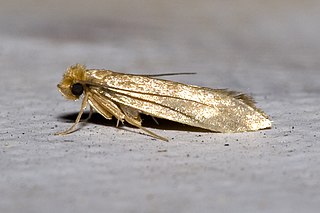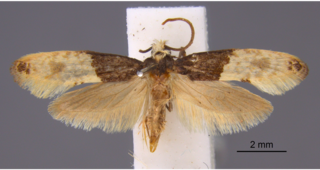
Tineola bisselliella, known as the common clothes moth, webbing clothes moth, or simply clothing moth, is a species of fungus moth. It is the type species of its genus Tineola and was first described by the Swedish entomologist Arvid David Hummel in 1823. It and a number of closely-related species are together known as the clothes moths due to their function as pests in human households. The specific name is commonly misspelled biselliella – for example by G. A. W. Herrich-Schäffer, when he established Tineola in 1853.

Trichophaga tapetzella, the tapestry moth or carpet moth, is a moth of the family Tineidae, commonly referred to as fungus moths. It is found worldwide.

Recurvaria leucatella is a moth of the family Gelechiidae. It is found in most of Europe, Turkey, Central Asia and the Caucasus.
Dasmophora is a moth genus, belonging to the family Tineidae. It contains only one species, Dasmophora xerospila, which is found in French Guiana.
Thomictis is a genus of moths belonging to the family Tineidae. It contains only one species, Thomictis ephorista, which is found in Guyana.

Monopis laevigella, the skin moth, is a species of tineoid moth. It belongs to the fungus moth family (Tineidae), and therein to the nominate subfamily Tineinae. It is the type species of the genus Monopis and its junior objective synonym Hyalospila. As with the common clothes moth, earlier authors frequently misapplied the name Tinea vestianella to the present species.
Petasactis is a genus of moths belonging to the family Tineidae. It contains only one species, Petasactis technica, which is endemic to New Zealand. This species has not been collected since prior to 1888. It is classified as "Data Deficient" by the Department of Conservation.

Archyala opulenta is a species of moth of the family Tineidae. This species is endemic to New Zealand and has been found in the upper Maitai Valley in Nelson as well as in Northland. The larvae of this species are associated with endemic bat species as they feed on the guano of Mystacinidae. The adult moths are on the wing in November. It is classified as "Data Deficient" under the New Zealand Threat Classification System by the Department of Conservation.

Tinea pallescentella, the large pale clothes moth, is a moth of the family Tineidae. It is found in most of Europe. It is also present in western North America, where it has been recorded from California. There are also records from South America and Australia.
Opogona autogama is a moth of the family Tineidae.

Trachycentra chlorogramma is a moth of the family Tineidae. It is found on the Cook Islands, Fiji, Papua New Guinea, the Solomon Islands and Tonga.
Scalidomia fetialis is a moth in the family Tineidae. It is found in West- and Central-Africa and on the Comoros.

Agonopterix curvilineella, the curved-line agonopterix moth, is a species of moth in the family Depressariidae. It was first described by William Beutenmüller in 1889. It is found in North America, where it has been recorded from Illinois, Indiana, Kentucky, Maine, Maryland, Massachusetts, Michigan, Minnesota, Mississippi, New Brunswick, New York, Ohio, Ontario, Quebec, Tennessee, West Virginia and Wisconsin.
Tiquadra cultrifera is a moth of the family Tineidae. It is known from Benin, Democratic Republic of the Congo, Ghana and Nigeria.
Stegommata hesperias is a species of moth in the genus Stegommata. It was named by Edward Meyrick in 1893. It is found in Australia, where it has been recorded from Western Australia.
Erechthias beeblebroxi is a moth of the family Tineidae. It is endemic to Australia, where it has been recorded from Queensland.

Amphixystis cymataula is a moth of the family Tineidae. It was described by Edward Meyrick in 1909 and is found in Zimbabwe.
Edosa cheligera is a moth of the family Tineidae. It was described by László Anthony Gozmány in 1970 and is found in Zimbabwe.

Crypsitricha agriopa is a species of moth in the family Tineidae. It was described by Edward Meyrick in 1888. This species is endemic to New Zealand.

Sagephora jocularis is a species of moth in the family Tineidae. It was described by Alfred Philpott in 1926. This species is endemic to New Zealand and has been collected in Canterbury and Southland. Adults are on the wing in January and October.










